what appeals to you most about the optometry field
RELATED CONTENT
![]()
Optometry, similar many medical professions, is being reshaped past the specialization trend. Mod living has inverse the way we use our eyes, and many optometrists, especially those in private do, accept responded by developing specialties to address specific patient needs. Some specialties, such as pediatrics and depression vision, accept been long established in optometry, while others, like dry heart direction and neuro-optometry are more than contempo additions. All the same all seem to be benefitting from the appearance of new technologies and handling methods which are bringing heady changes to vision intendance. This infusion of energy is attracting ODs looking to add a new dimension to their general exercise, or even create an entirely specialized exercise, as many ophthalmologists have done. Those who choose to specialize do it as a way to distinguish themselves and differentiate their practices.
Despite specialization's entreatment, about ODs remain generalists, believing that going broad rather than deep is a more practical strategy for success. Nonetheless both approaches can co-exist comfortably in a practice. In fact, ODs who specialize typically exercise so within the context of a full general exercise.
"There's a lot of means you tin approach the practice of optometry and be successful," noted dry center specialist Whitney Hauser, OD. "Nevertheless, fifty-fifty in a general eyecare do that's focus is primary care, there's all the same an opportunity to carve out a niggling something different from the guy down the street. To be successful at a specialty, though, y'all demand to inquire yourself three questions: What do you lot desire to practice? What are you good at? And, what's the need in your community? If you can observe something that intersects all 3, that's your pot of gold."
To improve understand what's driving the specialization tendency in optometry, Vision Monday looked at 10 types of specialty practices: sports vision, neuro-optometry, pediatric, senior care, dry centre, vision therapy, depression vision, contact lenses, myopia, aesthetics. The optometrists we spoke with explained why they observe their specialty rewarding, personally and professionally. They discussed how they have maximized that specialty to aggrandize their scope of practice, grow their patient base of operations and boost revenue.

Helping Young Patients Overcome Visual Challenges
Vision therapy is a well-established field encompassing behavioral and developmental vision care likewise every bit neuro-optometric rehabilitation. The appearance of new technologies and treatment methods in contempo years has added an important dimension to the field.
The College of Optometrists in Vision Evolution (COVD), a not-profit, international membership association of eyecare professionals provides board certification for optometrists and vision therapists who offer specialized vision care services to develop and enhance visual abilities and correct many vision problems in infants, children, and adults.
Nathan Bonilla-Warford, OD, FAAO, FCOVD
Vivid Eyes Family Vision Intendance
New Tampa and Westchase, Florida
| | 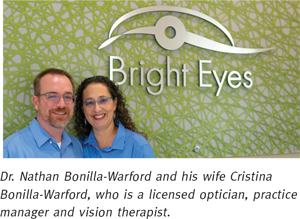 |
| | |
Although he gained a considerable amount of knowledge almost vision therapy, it wasn't until he bought his Florida practice, Bright Optics Family Vision Care, in the mid-1990s that Dr. Bonilla-Warford began implementing it with patients, especially children. "We found a neighborhood within the Tampa Bay area that was family oriented and children-axial, and that was important to grow the vision therapy programme," he explained. "Information technology'south a very important function of the do growth."
Bright Eyes Family Vision Center's vision therapy program treats conditions such as amblyopia, strabismus, depth perception and suppression. Dr. Bonilla-Warford employs the latest technologies including Vivid Vision, a virtual reality Vision system created for treatment of various binocular vision problems. Bright Vision uses the Oculus Rift virtual reality platform to provide therapeutic activities.
One of the approaches Bright Eyes uses to treat amblyopia is the patent-pending Shaw lens, a digital, binocular lens arrangement. The lens'south exact upshot on the vision system tin can be readily analyzed, and benefits of a Shaw design are the graphically displayed earlier the lens is ordered.
Specializing in vision therapy has proved to exist rewarding for him, both personally and professionally. "When you're doing vision therapy, every case is unlike," said Dr. Bonilla-Warford. "It'southward a lot more challenging. You take to become a lot more in-depth and think about the patients in a dissimilar way. But you also get to see patients many times over the course of handling, and get to know them extremely well, also as know their parents. Knowing how much of a positive impact you're having on them makes every mean solar day a lot more interesting and challenging. It's definitely a lot of fun."
Dr. Bonilla-Warford said vision therapy has been a practice architect. "If people are coming to y'all considering they have a particular problem and have been referred by a professional person, they are much more than likely or willing to pay out of pocket for your specialized expertise, and less concerned nearly what type of vision program they have. Nosotros have a pretty large segment of our patient population who will pay out of pocket and either endeavor to get reimbursement on their ain and non use their benefits. That'due south directly related to having specialty services that people want.
"We made the choice early to participate equally fiddling as possible in medical plans. We do accept Medicare. It streamlines everything. People simply give usa cash, we deposit it directly and everybody's happy."
—Andrew Karp

Neuro-Optometry, a Rewarding Specialty for Optometrists
The Neuro-Optometric Rehabilitation Clan (NORA) defines neuro-optometry as a customized treatment regimen for patients with visual deficits caused past physical disabilities, traumatic brain injury (TBI) and other neurological problems. It is a part of the rehabilitation procedure for visual/perceptual/motor disorders similar acquired strabismus, diplopia, binocular dysfunction, convergence and/or accommodation paresis/paralysis, oculomotor dysfunction, visual-spatial dysfunction, visual perceptual and cerebral deficits, and traumatic visual acuity loss.
Treatments used include medically necessary non-compensatory lenses and prisms with and without occlusion and other appropriate medical rehabilitation strategies similar patching i middle or part of the visual field of one centre to resolve double vision. Neuro-optometrists oft work closely with neurologists, concrete medicine and rehab physicians, nurses, physical and occupational therapists, speech-language pathologists, neuropsychologist, and audiologists.
Susan Daniel, OD
Daniel & Davis Optometry
Carlsbad, California
| | 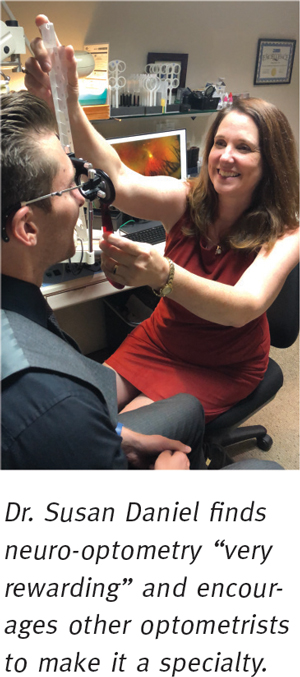 |
| | |
"My husband and I run a group exercise with two other optometrists, and three of us exercise neuro- and developmental optometry in addition to primary-care optometry, while my husband focuses entirely on primary care services," explained Dr. Daniel. She operates Daniel & Davis Optometry in Carlsbad, Calif. with her husband, Christopher Davis, OD.
Dr. Daniel now spends much of her time at her dispensary and at an area infirmary in the acute rehabilitation unit (she has hospital privileges), working with patients who have suffered traumatic brain injury (TBI, such equally concussion) or stroke also as those with special needs and autism who are diagnosed with strabismus, diplopia, binocular dysfunction, accommodation dysfunction, oculomotor dysfunction, visual perceptual-motor and visual-spatial dysfunction.
Dr. Daniel frequently works aslope and in coordination with occupational therapists, physical therapists and other rehabilitation medicine specialists on visual rehabilitation. She often uses lenses, tints, selective apoplexy, compensatory prism, yoked prism and vision therapy to help these patients perform day-to-day tasks, amend their posture, ability to walk, depth perception and visual comfort.
Information technology'south a direction for her career that she would never accept imagined until her son suffered a brain injury, and related vision consequences, when he was a i-year-sometime. Her son'due south condition prompted Dr. Daniel to attend her starting time NORA meeting. "I was just blown away," she recalled. "Everything they were talking about wasn't taught in optometry schoolhouse xxx years ago, merely I knew these services would help my son recover."
Her son, who is as well autistic, is 22 now and doing well. He'south non-verbal, but his visual skills have improved sufficiently to let him to employ an assistive engineering text-to-speak programme to communicate, to write and to be more independent.
Now, with NORA, Dr. Daniel is encouraging other optometrists to accept on the neuro-optometry specialty. NORA provides clinical courses to teach optometrists the skills needed to provide neuro-optometric rehabilitation for their patients. Opportunities to acquire with lectures and workshops are also provided by the Optometric Extension Program (OEP), the College of Optometry in Vision Development (COVD), the American Optometric Clan (AOA), residency programs and other continuing pedagogy.
As nearly neuro-optometry patients pay cash for the services, the specialty can exist quite lucrative. In fact, Dr. Daniel noted, the specialty helped Daniel & Davis Optometry navigate the 2008 recession, when revenues from conventional center exams and eyeglass and contact lens sales declined.
"The revenue generated from a two-hour rehabilitation consultation is more four main-care eye exams," she explained. "These patients are looking for care not provided past many other eyecare professionals. They want their visual issues solved and they'll pay for that. But, of class, it's more than that. Y'all can make such a difference in the lives of your patients with neuro-optometric rehabilitation. It's very gratifying."
—Brian Dunleavy

Taking Sports Vision to the Major League Level
Sports vision optometry has been defined as the practise of examining an individual patient's visual arrangement and ensuring that information technology is maximized for functioning in the able-bodied loonshit. This includes, only is non limited to, advising athletes on the most appropriate method of refractive correction for the sport(southward) they play, discussing ocular health and condom and measuring ocular strengths and weaknesses in the context of the sports they play (such equally visual reaction fourth dimension).
A sports vision screening typically includes evaluation of visual acuity, ocular alignment, eye teaming and depth perception, peripheral awareness, eye movements, motivation, and visualization, with particular focus on the visual demands of the athlete'southward chosen sport(s), such as the need to aim for a specific target or the operation of nigh and/or far tasks.
Keith Smithson, OD
Northern Virginia Doctors of Optometry
Washington, D.C.
| | 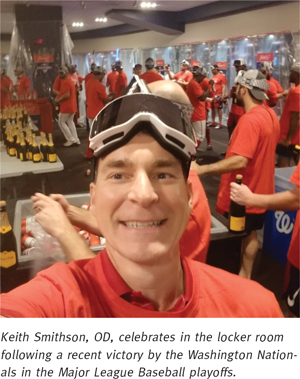 |
| | |
Dr. Smithson is the director of Visual Functioning for Major League Baseball'southward Washington Nationals and the team optometrist for the NBA's Washington Wizards, the WNBA'southward Washington Mystics, the NWSL's Washington Spirit, NFL'southward Washington Redskins and D.C. United of MLS. He likewise serves as sports vision consultant for the NHL's Washington Capitals.
Clearly, when it comes to sports in the nation'due south capital, he has all the bases covered, so to speak.
"I would say an overwhelming corporeality of my practice is in some fashion related to my affiliation with sports," said Dr. Smithson, a lifelong athlete who decided to explore sports vision as soon as he graduated from the Pennsylvania Higher of Optometry in 2000. "I saw [the specialty] as a way to integrate two things I loved: optometry and sports."
Indeed, in his day-to-day practice at NVDO, Dr. Smithson passes forth the expertise he has gleaned working with the pros to athletes of all ages who are seeking an "extra edge" in performance through vision enhancement. He also conducts visual and perceptual testing for children experiencing difficulty in schoolhouse, and for adults with calculator vision eye strain or focusing problems.
The products he dispenses include sport-safety and sport-active frames and contact lens options with features and benefits geared toward athletic enthusiasts, such as Acuvue Oasys with Transitions. During exams, he performs dynamic vision testing with systems like RightEye, Neurotracker, Senaptec and Binovi, and "trains" athletic patients using technologies similar VIMA or Senaptec Strobe Preparation glasses, EQ Trainer, and Vizualedge.
In add-on, Dr. Smithson treats vision bug related to mail service-concussion syndrome—a major issue in all levels of sports these days—like double vision or blurred vision. He and his colleagues at the practice have also created sportsvisionpros.com and performancevision.academy to brainwash ECPs, allied health professional person partners and others—including able-bodied trainers, coaches, parents and the athletes themselves—on sports vision testing and vision solutions.
These services take brought additional patients into his do, and the specialty serves as a central commuter of patient book and exercise revenue. Having the human relationship with the local sports teams certainly helps from a marketing perspective as well, and adds to his credibility equally a sports vision specialist. However, Dr. Smithson is quick to emphasize that the most of import aspect of his sports vision practice is the bear upon information technology has had on the intendance he provides all of the patients he sees.
"I shy away from calling sports vision a specialty because I truly believe all of my colleagues can do almost of what I do every solar day with just a piffling fleck more time and attention to the needs of athletes, without any additional investment," said the sometime chair of the American Optometric Association's Sports and Functioning Vision Committee. "Many sport vision concepts, such as peripheral awareness, visual reaction time, eye tracking, dissimilarity sensitivity and depth perception are also relevant when driving, multi-tasking at work and just performing at our superlative in a visually demanding world."
—Brian Dunleavy

Serving Needs of Older Patients May Be the Key to a Successful Practice
Senior vision optometrists typically specialize in the diagnosis and direction of vision loss associated with ocular diseases that often impact the middle health and vision of patients 65 years of age and older. These include those diagnosed with age-related macular degeneration (ARMD), cataracts, diabetic retinopathy, glaucoma, retinal detachment and dry out middle.
In some states, optometrists may exist actively involved in managing the care of patients with these conditions. However, in others, their part may be express to addressing the vision needs of these patients, prescribing eyeglasses with special tints and/or prisms to help them compensate for vision loss and/or dispensing low-vision aids such equally magnifiers.
Mark T. Marciano, OD
Marciano Family unit Optometric
West Palm Beach, Florida
| | 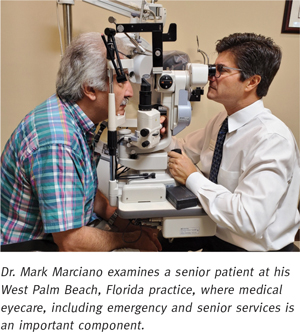 |
| | |
From an eyecare perspective, the AOA notes, older patients are likely to present with pregnant visual-health needs, due to high-myopia and/or presbyopia or the presence of ocular diseases such as age-related macular degeneration (AMD), cataracts, diabetic retinopathy, dry center or glaucoma. Many of their vision problems tin be traced to other health issues associated with aging.
For Marciano Family Optometric, which is located in the pop retirement locale of West Palm Beach, Fla., serving older patients has become primal to the exercise's success. According to Marking T. Marciano, OD, approximately 35 percent of the patients seen by the do come for "medical eyecare," including emergency and senior services.
"About all senior patients that we see want to maintain an active, happy and salubrious lifestyle, and their vision and ocular condolement is a big part of that," noted Dr. Marciano, who owns the practice with his wife, Brandee Owens Marciano, OD. "Patients who are a bit older, with more complex visual and ocular needs aren't looking for the cheapest price or the quickest service. This demographic wants to exist treated with respect and given the adequate amount of time to discuss their issues and are looking to accept their providers spend a few extra minutes listening and providing sound medical advice that tin can solve these bug.
"This demographic is often in a ameliorate financial position to pay for services that can improve their lifestyle, which ultimately creates a more rewarding patient interaction and a more assisting one, too. And the ability to nib a patient's medical insurance for the necessary diagnostic testing provides us the power to provide full scope of services and gain some added financial benefit to the exercise."
Considering dry center is more prevalent among older adults, for example, its diagnosis and treatment have become an important growth expanse for Marciano Family Optometric. The part is equipped with retinal photography, October and computerized dry center technologies to "provide whatsoever services our senior patients need," Dr. Marciano noted.
And, as a referral center for many corneal specialists in their local area, the exercise has too been increasingly involved in dispensing scleral contact lenses for those with corneal diseases, such every bit keratoconus and pellucid marginal degeneration or penetrating keratoplasty resulting from past refractive surgery, such every bit LASIK, PRK and RK.
"There are not besides many optometrists who have taken the time to larn the nuances of plumbing equipment specialty contact lenses," explained Dr. Marciano, who also serves as mayor of nearby Palm Beach Gardens, Fla. "Condign an expert in these lens options has positioned our office equally the local 'go-to' clinic for patients with special needs."
The practice is looking to attract another colleague to specialize in the dispensing of depression vision devices for patients with AMD and glaucoma. "There is such a need for low vision services and many of our colleagues are not trained to offer vision devices for these patients," Dr. Marciano explained.
"Low vision devices can greatly improve the independence of our patients, which tin truly help people. It tin can likewise provide another method of subspecialty which most practices don't appoint in. This can increment patient referrals and offer some other profit center."
—Brian Dunleavy

A Dry out Middle Specialty Can Reap Rewards for ECPs
Optometrists who specialize in dry eye focus on the management of the symptoms associated with 1 of the most common ocular diseases—that is, the inability to produce sufficient tears to maintain proper lubrication of the eye. As a condition, dry eye may exist acquired by allergies, contact lens wear or the presence of ocular diseases, including diabetic retinopathy.
Since the advent of the Dry out Centre Workshop, which published the second revision of its guidelines in 2017, numerous studies on the appropriate assessment and management of dry out eye have inverse the telescopic of practice for those who specialize in the field of study.
Artificial tears are perhaps the virtually well-known dry eye treatment, only optometrists may also prescribe nutritional supplements that help encourage tear development and advise patients on vision-correction solutions that may farther improve their condition.
Whitney Hauser, OD
Middle Specialty Grouping
Memphis, Tennessee
| | 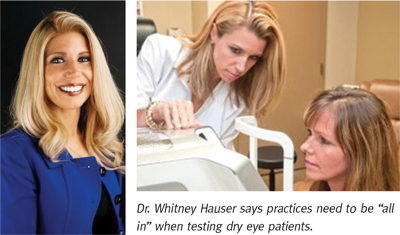 |
| | |
"At that place's a lot of ways you can approach the practise of optometry and be successful," she said. "Withal, fifty-fifty in a general eyecare practice that is focused on principal intendance, there'due south still an opportunity to carve out a little something dissimilar from the guy downwards the street. To exist successful at a specialty, though, you need to enquire yourself three questions: What do you want to practice? What are you good at? And, what's the demand in your community? If you lot can find something that intersects all three, that'south your pot of gilt."
For many, dry centre may just be the prize at the end of the rainbow. A study published in 2017 in the American Journal of Ophthalmology estimates that more than than 16 million American adults take the condition, only experts like Dr. Hauser feel that, if anything, the number is really far greater, given that it oftentimes goes undiagnosed. And, the prevalence is only likely to increment due to the ageing of the American population as well as increases in contact lens wear and the use of digital devices (dry out heart is just 1 facet of so-called "digital eye strain"), among other factors.
Co-ordinate to Dr. Hauser, dry eye is the ideal practice builder considering women between xl and 60 years of age are at increased risk for the condition. This is significant, as research suggests these individuals often serve as health care "gatekeepers" for families as the primary decision-makers with regard to md choice.
Furthermore, dry out center sufferers are ofttimes frustrated with the condition and its symptoms. Studies have noted loftier rates of depression and anxiety* among these patients, many of whom "think zippo tin can exist done about information technology," noted Dr. Hauser, who serves as Dry Centre Clinical Development consultant at the Centre Specialty Grouping, an ophthalmic surgery center in Memphis, and every bit director of Clinical Diplomacy for Keplr Vision, which operates 80 eyecare clinics across xix states. (At Keplr, she is in the process of crafting a "dry out eye protocol" for the company'due south network of doctors.) So, optometrists who can successfully treat the condition and its symptoms have an opportunity to build a long-term physician-patient relationship—one that is probable to heave bottom line results through ongoing dry center services likewise as future eyeglass and contact lens sales.
To be successful, though, Dr. Hauser emphasizes that practices considering a dry specialty need to be all-in—and that means doing the "internal marketing" (educating staff on the condition and setting the parameters for how the practice will care for it) before investing resource in any new equipment or products.
Once the practice is committed, The Dry Eye Workshop Written report tin provide a roadmap for setting upwards the diagnostics and providing guidance on the nigh effective handling options, she said. Dr. Hauser is too founder of Bespeak Ophthalmic Consulting and DryEyeCoach.com, both of which are focused on helping ECPs set upwards a dry eye specialty.
—Brian Dunleavy

Specializing in Myopia Is a Big Commitment for ECPs
Myopia refers to blurry eyesight caused past nearsightedness, or the inability of the eye to focus on objects at a particular altitude away. High myopia refers to nearsightedness of a higher degree than average, commonly above -6.00 diopters (worse than 20/400 uncorrected vision). Equally much myopia is progressive in nature, there is e'er concern in myopic patients that their status will lead to higher and higher powers of myopia, hence "high" myopia.
Peer reviewed inquiry suggests which methods have the best take a chance of stabilizing changing vision due to progressive myopia. Overall, Orthokeratology (ortho k) has been shown to accept the greatest issue. Orthokeratology is one of a grade of therapies known equally vision shaping treatments. OrthoK involves wearing orthokeratology lenses (ortho one thousand lenses) during sleep, which gently reshape the surface of the cornea of the eye. Upon removal in the forenoon, clear vision is achieved which often lasts the entire solar day into the evening. Options such as OrthoK, cornea refractive therapy including paragon crt (vision shaping treatment) are specially helpful when seeking to improve eyesight in children, and reduce change in vision, specifically myopia in children.
Gary Gerber, OD
Treehouse Eyes
Bethesda, Maryland
| | 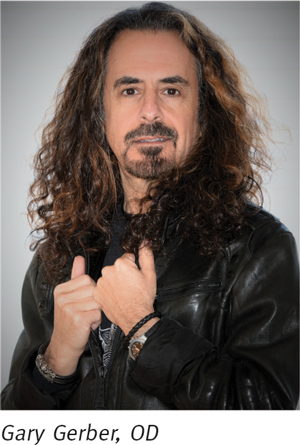 |
| | |
Indeed, a recent Sydney Myopia Study found 31 pct of 17-year-olds were myopic, double the prevalence reported past the Blue Mountain Eye Study more than a decade ago. Simply in the future, even nations which have piddling myopia today, will be severely affected, according to the plant.
While the hot spots of myopia are Due east and Southeast Asia (where a few countries accept a myopia prevalence charge per unit of 80 per centum to 90 percentage). All the same, myopia prevalence is growing worldwide, and the U.S. has reported a prevalence of 42 pct, which is almost double the prevalence 30 years ago, according to the institute.
The potential consequences of this myopia trend are severe. Uncorrected refractive error (URE) volition increase substantially, cataract and glaucoma-fraction attributable to myopia likely to increase, blindness and vision impairment due to myopic macular degeneration (MMD) and myopia retinopathy in adults will increase substantially.
Research from the Brien Holden Vision Constitute and its collaborators show that in that location are better ways to manage the onset and progression of myopia. Clinical trials involving children with myopia bear witness it is feasible to diminish the progression of myopia for a better visual outcome for the child.
Nonetheless, according to Gary Gerber, OD, a co-founder and principal myopia eradication officer at Treehouse Eyes, said that while treating myopia will become increasingly of import beyond eyecare "bringing any specialized service into a chief care practice isn't for anybody."
He added, "After the obvious requirements of increasing the requisite specialized clinical skills and grooming, added costs of necessary technology, staffing, [amidst others], the almost of import factor to consider is the willingness to commit and be prepared to deal with the challenges of the specialty affecting a dr.'due south cadre do.
"For example, well-nigh every area of specialization requires more fourth dimension than a typical principal care visit. Not properly addressing this in accelerate can cause your primary care practice to suffer. Non allocating enough resources to staff training and specialized systems is another [result to] watch out. All of this said, practices willing to go 'all in' with whatever specialty they choose, are more probable to succeed vs. those who dabble."
Dr. Gerber also noted that the Treehouse Eyes program allows doctors to bring myopia direction into their practices with a proven system that addresses these challenges. "Doctors working with us report the program has allowed them to bring a comprehensive myopia management program—clinical excellence through social media strategy and everything in betwixt—in a more efficient, cost effective and highly assisting manner than if they attempted to practice information technology themselves," he said.
"In fact, many of our doctors report previous attempts to launch a program themselves and realizing early, 'This is manner more than work than I idea information technology'd exist. There's got to be a better way.' Treehouse Eyes is the solution for those doctors."
—Marker Tosh

The Growing Opportunity for Depression Vision Optometry
The American Foundation for the Blind offers 2 definitions of depression vision. The beginning is related to visual acuity: Low vision is a status caused by eye disease, in which visual vigil is xx/seventy or poorer in the ameliorate-seeing heart and cannot exist corrected or improved with regular eyeglasses. (Scheiman, Scheiman, and Whittaker)
The second is a functional definition: Low vision is uncorrectable vision loss that interferes with daily activities. It is better defined in terms of function, rather than [numerical] test results. (Massof and Lidoff).
Optometrists who specialize in treating low vision patients tin can offer a broad range of solutions, depending upon the degree of vision loss experienced, including many new technologies. And with the number of low vision patients growing exponentially as a result of the aging population, the need for optometrists who specialize in depression vision is greater than ever before.
Bryan Wolynski, OD
Possessor, Glasses On Beginning
New York City
| | 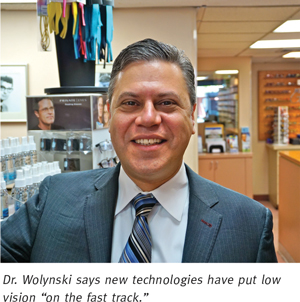 |
| | |
Subsequently an initial involvement with Florida'southward Miami Lighthouse, he started edifice a low vision practice within his New York City location, Glasses on First. The offset step was putting together a fitting set including diverse magnifiers and other technologies. Side by side, he put the word out to local ophthalmologists that he was looking for low vision patients. They began referring patients, and soon optometrists in the surface area did, too.
One reason for these doctor-to-doctor referrals is that some patients, upon learning they have a potentially blinding eye status, are wary at first of going to an established dispensary known for treating bullheaded and low vision patients. "People don't like to hear they're going blind. That'southward why some doctors under-refer to united states of america," Dr. Wolynski said. "Patients feel more comfortable coming here."
Dr. Wolynski smooths the style with a preliminary phone call, and presents patients with an information packet when they get in, which lets them know what to expect from low vision treatment, including the cost of assistive devices they may require.
"Low vision is really on the fast track these days, especially when it comes to engineering," said Dr. Wolynski. He employs avant-garde devices such as Orcam, a compact, computer-powered device that clips onto the patient's glasses and tin can read text and recognize images and the Ocutech Falcon, an autofocus telescope.
Because in-office consultations with patients can be time consuming, some optometrists refer to the field every bit "tiresome vision." But Dr. Wolynski believes that is a misperception. "I might spend an hour-and-a-half with a patient, only they're paying for my time," he contended. "Y'all can neb information technology through medical insurance through time codes, although I don't take any medical plans, I only take direct payment. And patients buy something, whether it'due south magnifying device or a pair of glasses.
For example, a lot of patients come in wearing progressives. Why are they wearing progressives, which inherently take some distortion? They should be wearing bifocals or single vision. So correct away, we're helping somebody. Then in that location are certain filters and sunglass lenses the might need. It adds up."
Give-and-take-of-mouth referrals contribute significantly to the growth Dr. Wolynski'due south depression vision do. "My patients, even the ones who aren't visually impaired, look at it like your helping in the community. Often they'll say, I have a grandmother, aunt or blood brother who could utilise your help."
Starting a low vision practice doesn't require a substantial investment, said Dr. Wolynski. "Y'all begin by just talking with patients and having a few magnifiers and other devices on hand," he advised. "It doesn't take much money to put together a little kit with magnifiers or devices. Whatsoever optometrist can practice basic low vision."
—Andrew Karp

Contact Lens Segment of Eyecare Is Often an Untapped Revenue Stream
According to the FDA's website, contact lenses are a primary choice for many people with vision correction needs. Contact lenses provide flexibility and convenience, and there are many different lenses available for a variety of needs and preferences. Contact lenses can be used to right a variety of vision disorders such as myopia (nearsightedness), hyperopia (farsightedness), astigmatism, and presbyopia (poor focusing with reading material and other near vision tasks).
There are ii general categories of contact lenses—soft and rigid gas permeable (RGP). All contact lenses crave a valid prescription. Soft contact lenses may exist easier to suit to and are more than comfortable. Newer soft lens materials include silicone-hydrogels to provide more oxygen to the eye. Rigid gas permeable contact lenses (RGPs) are more durable and resistant to deposit buildup, and generally give a clearer, crisper vision.
Ian Whipple, OD
Vision Source of Farr West
Farr West, Utah
| | 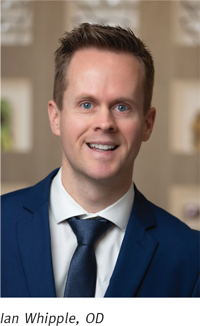 |
| | |
But at that place are exceptions, of course. Co-ordinate to Ian Whipple, OD. of Vision Source of Farr W, Utah, his two-dr., fifteen-support staff exercise "loves fitting contact lenses." He added, "Many patients desire glasses-gratuitous options and contact lenses tin can offer them freedom to pursue their dreams. Nosotros find that contact lens patients understand the health of their eyes better than spectacle lens just patients.
"I think this is considering of the extra accent we stress on ocular health during the contact lens evaluation process. Contact lens patients return to our clinic for their yearly exams at a more frequent rate. They typically purchase more from us and seem to be more than loyal."
Dr. Whipple also noted this his function tries to keep things simple for contact lens patients. "We recognize that they want convenience and a expert price. We offering both of those by, first, pricing our lenses competitively and, secondly, nosotros do the shopping for them. That is, we give every patient a custom contact lens quote that shows their out-of-pocket expenses in a per-box price after discounts, rebates, and insurance savings."
Farr W has been utilizing CLX for ordering and fulfilling subscriptions for about a year, which enables the patient to reorder online directly from its function. The convenience of this service makes all the divergence for some patients, Dr. Whipple said. "We actually stress eye wellness during our exams and it seems that the bulletin is getting through because our contact lens patients are more than compliant with their almanac exams," he added.
Katie Andrews, OD, FAAO
Campus Eye Center
Lancaster, Pa.
| | 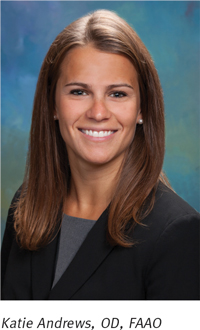 |
| | |
Her practice also has a "specialized attribute" within the contact lens segment because she has "numerous aphakic patients that I have been plumbing fixtures since they were a few months old."
She added, "I notice that patient education is the best manner to keep patients returning for their annual contact lens checks and purchasing lenses directly from the practice. Our role too prepares an invoice of the cost of purchasing contact lenses through the practice with the rebates that come directly from the companies versus the toll on some of the online vendors. By specifically writing this out for patients they are frequently shocked that it is cheaper to buy lenses through the practice than [via other options]."
—Mark Tosh

Helping The Youngest Patients See Conspicuously and Await Good
Taking care of children'due south vision needs is a specialty expanse is taking on new meaning in 2020, as sensation of the connection between vision and learning starts to only gradually build among parents and just as new research about myopia comes onstream. A kid's eyes go through rapid changes, especially in the first six years of life. Just fewer than xv percent of preschool children receive an eye exam by a professional, according to the Centers for Disease Control and Prevention. And while vision screenings take become ubiquitous in schools across the land, they aren't enough. Schoolhouse vision screenings miss up to 75 pct of children with vision issues. And 61 per centum of the children found to have eye problems through screenings never visit the doctor or get help.
The American Optometric Clan (AOA) recommends scheduling a baby's first middle exam around half-dozen months of age. The group established InfantSEE (https://www.infantsee.org/) equally a public health awareness program of its Optometry Cares Foundation to build cognition on the topic and assistance parents find practitioners. The AOA's recently issued bear witness-based clinical practice guideline is another important resources, Comprehensive Pediatric Eye and Vision Examination.
Linda Chous, OD
The Spectacles Menagerie
Minneapolis, Minn.
| | 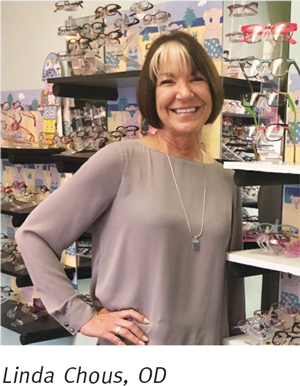 |
| | |
—Marge Axelrad

Addressing Wellness Treatments, Cosmetics and The Center
Aesthetics optometry, which offers corrective improvements and wellness treatments to the heart area, is a relatively newer specialty expanse, merely one existence embraced by many as a practise enhancement to provide patients with additional service. Men and women both are seeking treatments to improve the appearance of their eyes and eyelid skin. And patients increasingly expect their centre doctors to be experts about anything having to practice with their eyes and the skin surrounding their eyes.
Optometrists sometimes necktie aesthetics services into those that they already provide, such as for dry eye. Dr. Jennifer Lyerly, Triangle Visions Optometry, shared in a recent Review of Optometric Business organization article, "The key to elevating ocular aesthetics as a true specialty to put beside dry heart or glaucoma intendance is to care for it as a science. The way we practise ocular aesthetics overlaps very much with our dry eye specialty. When we are treating dry out eye, addressing the cosmetic products and procedures our patients use, and the side effects they may cause, is an essential foundation building block to their dry heart treatment."
Dr. Lyerly points out, "If I treat their dry out center, but ignore the ocular surface offenders they are using on a regular ground, am I really fully treating the issue? In my opinion, it'south impossible to separate specializing in dry centre care from also specializing in ocular aesthetics."
She notes the importance of education in this nascent only growing specialty. "If yous want to spring-start learning more about the most common ocular surface irritants in corrective products, cheque out Vampires on the Vanity past ophthalmologist, Laura Periman, Medico, and become a member of the collaborative OD/Dr. community on the Ocular Surface Facebook forum OSDocs. In addition, Advanced Ocular Care has done an excellent task featuring articles from the leading ocular aesthetic and anti-aging eyecare specialists effectually the country. Bridgitte Shen Lee, OD, Leslie O'Dell, OD, and Whitney Hauser, OD, are optometrist-thought leaders in the field."
—Marge Axelrad
richardsoninattica.blogspot.com
Source: https://www.visionmonday.com/eyecare/eye-health/article/specialized-optometry/
0 Response to "what appeals to you most about the optometry field"
Post a Comment